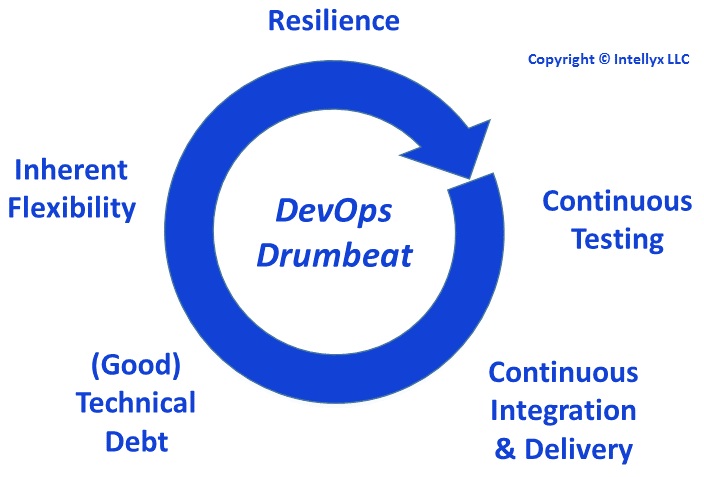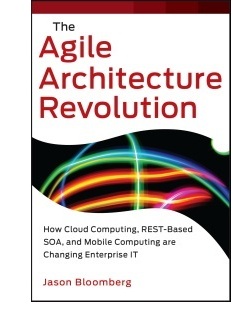Check Point® Software Technologies Ltd.(link is external) announced that U.S. News & World Report has named the company among its 2025-2026 list of Best Companies to Work For(link is external).
Start with The DevOps Drumbeat - Part 1
Introducing the DevOps Drumbeat
The move to DevOps also introduces additional constraints to our burgeoning Iron Polygon, as individual projects become less distinct. In an environment focused on continuous automated testing as well as continuous integration and deployment, individual iterations become the project unit as organizations establish regular cadences of repeated iterations(link is external) instead of the discrete, monolithic project releases that characterize traditional waterfall-oriented development.
Rethinking the Iron Triangle in terms of DevOps cadences instead of software projects changes everything, as it brings the entire discussion up a level, as shown in the diagram below. In fact, each neighboring pair of constraints on the AA Quality Star leads to a new constraint.

Applying the DevOps Context to the AA Quality Star
Scope and agility connect to drive inherent flexibility. Agility and quality lead to resilience. Quality and cost factor into continuous testing. Cost and time drive continuous integration and deployment. And finally, time and scope connect to form the fifth new constraint, technical debt – not the bad kind where time constraints lead to sloppy code, but the good kind where the team intentionally introduces shortcuts or missing functionality into the current iteration as part of the overall cadence.
Essentially, DevOps doesn't allow us to formally discard the Iron Triangle, but it does let us do an end run around it. Remember, the Iron Triangle says that for a particular project, scope, cost, and time must balance. In contrast, the DevOps way of thinking says don't think about particular projects any more. Instead, think about the cadence. If we can shift elements of scope, cost, and time forward or backward in our cadence – a concept that doesn't make sense in Iron Triangle terms – we can build better, more flexible software overall.
Let us therefore put away the Iron Triangle as well as the AA Quality Star, and introduce the DevOps Drumbeat, shown in the figure below.

The DevOps Drumbeat
Every cadence consists of drumbeats that set the overall pace of the effort within the context of the constraints in the diagram above. For each drumbeat – possibly an individual sprint or other iteration, or perhaps a finer-grained measure – the DevOps team must balance the five constraints.
The Intellyx Take: Connecting the Drumbeat to Agile Architecture
 This article may be introducing the phrase DevOps Drumbeat, but obviously many of the ideas included in the figure above aren't new. What is new is calling out the five DevOps constraints as such and putting them in a set that is analogous to the Iron Triangle. We're also taking the novel step of representing the drumbeat as a circle, rather than a polygon. After all, DevOps should have no corners!
This article may be introducing the phrase DevOps Drumbeat, but obviously many of the ideas included in the figure above aren't new. What is new is calling out the five DevOps constraints as such and putting them in a set that is analogous to the Iron Triangle. We're also taking the novel step of representing the drumbeat as a circle, rather than a polygon. After all, DevOps should have no corners!
Furthermore, as DevOps practices mature, teams are likely to want to maintain resilience, continuous testing, and continuous integration and delivery. As a result, for each drumbeat, the tradeoff will be between inherent flexibility and good technical debt.
This tradeoff is at the heart of Agile software architecture, as the Agile architect (or team members contributing to the Agile architecture role) must decide how much technical debt to take on in order to build inherent flexibility into their software.
Jason Bloomberg is President of Intellyx.
Industry News
Postman announced new capabilities that make it dramatically easier to design, test, deploy, and monitor AI agents and the APIs they rely on.
Opsera announced the expansion of its partnership with Databricks.
Postman announced Agent Mode, an AI-native assistant that delivers real productivity gains across the entire API lifecycle.
Progress Software announced the Q2 2025 release of Progress® Telerik® and Progress® Kendo UI®, the .NET and JavaScript UI libraries for modern application development.
Voltage Park announced the launch of its managed Kubernetes service.
Cobalt announced a set of powerful product enhancements within the Cobalt Offensive Security Platform aimed at helping customers scale security testing with greater clarity, automation, and control.
LambdaTest announced its partnership with Assembla, a cloud-based platform for version control and project management.
Salt Security unveiled Salt Illuminate, a platform that redefines how organizations adopt API security.
Workday announced a new unified, AI developer toolset to bring the power of Workday Illuminate directly into the hands of customer and partner developers, enabling them to easily customize and connect AI apps and agents on the Workday platform.
Pegasystems introduced Pega Agentic Process Fabric™, a service that orchestrates all AI agents and systems across an open agentic network for more reliable and accurate automation.
Fivetran announced that its Connector SDK now supports custom connectors for any data source.
Copado announced that Copado Robotic Testing is available in AWS Marketplace, a digital catalog with thousands of software listings from independent software vendors that make it easy to find, test, buy, and deploy software that runs on Amazon Web Services (AWS).
Check Point® Software Technologies Ltd.(link is external) announced major advancements to its family of Quantum Force Security Gateways(link is external).
Sauce Labs announced the general availability of iOS 18 testing on its Virtual Device Cloud (VDC).












